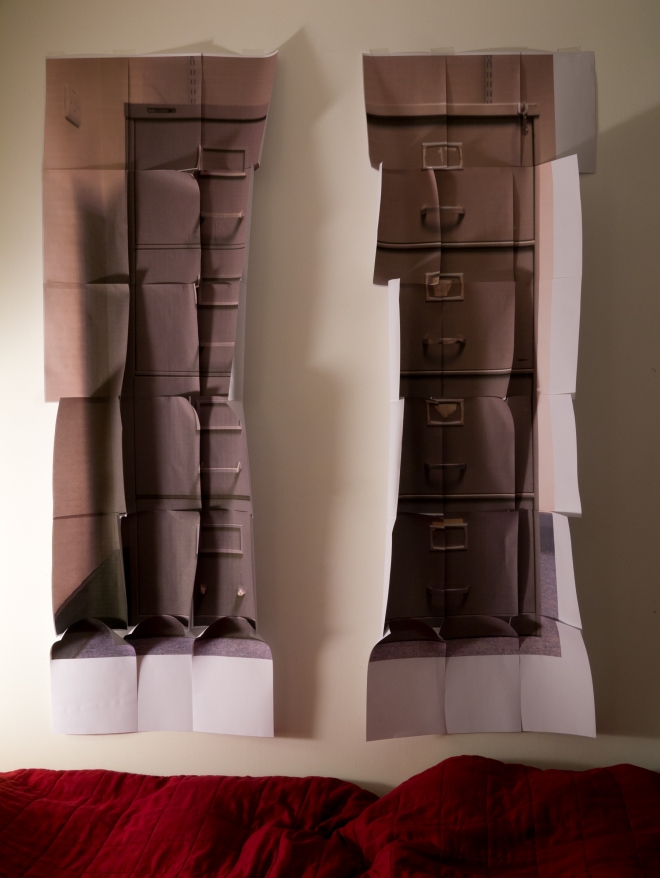This post contains the documentation of the assignment submission for Part 1, entitled the gap. The assignment consists of a 170cm x 150cm wall installation of 36 printed A4 sheets, attached to each other and the wall with clear tape.
The assignment submission as such consists of one digital photograph of the installation in situ:

The development of the assignment is documented in four related posts, which provide more detail to this summary post.
Also, a reflection on the assessment criteria is supplied in a separate post, here.
Two course projects were particularly significant for the development of the assignment: the one on using space provided a means of producing a series of works which in their wallspace configuration opened up towards a more detailed investigation of the paper edge and what takes place in the space (the wallspace in this case) beyond that edge [see original post on the project here]. From this arose an interest in developing a piece of work which in fact relates different items through their spacing on a wall – so, rather than working in series to conceive of the pieces as equal (not as part of a consecutive, developmental process) and to investigate their spatial configuration more akin to a photographic series or set in a gallery space. The project on rescaling opened up the question of how scale functions in the relationship between object and viewer, in particular as to the effect of upscaling, or, in fact: of providing a 1:1 scale for a large object [see original project post here].
The object in question is a pair of metal filing cabinets situated in an institutional office space. More precisely, the initial investigations revolved around the shadow space between these two cabinets, with one leaning slightly towards the other. As contextual influence for this I turned to Gordon Matta Clark’s large-scale architectural work involving abandoned buildings, see a post here)
Inspired by the installation work of contemporary photographers such as Noemie Goudal (such as Les Amants, 2009) and Alexandra Leykauf (such as Spanische Wand, 2013, discussed in a Digital Image and Culture blog here), I took to printing out the filing cabinet (at 132 cm height) in life size on my office inkjet printer. The rationale for the medium being that throughout Part 1 I had investigated office materials as a means of drawing (notably: mechanical pencil and thin-papered notebook as sketchbook). I am recreating the cabinets to scale but of a different matter, a different representation.
When trying to assemble the sheets, I realise that the column that contains the middle space, the actual gap, remains indeterminate in its extension: without a ruler I cannot determine where the left cabinet ends and the right one starts. I realise that this gap in the re-production is significant and presents a transformation of the initially observed shadow gap. I keep it and focus my attention on it.
Two obvious routes for further development arise for me: (a) to resituate it next to the actual filing cabinets; (b) to focus in on the details of the installation: its edges, gaps, extension into three-dimensional space, also as it interacts with the air humidity and begins to curl up.
Below I am also including a series of images as sample across the work process.
It’s interesting and inspiring watching this course unfold for you – I’m not sure I would do drawing, although I am wanting to head towards fineart rather than straight photography on its own. And to see how you bring all these elements into the work fascinates me. Hope the feedback is useful and encouraging.
LikeLike
thank you… Catherine and I talked a but about those links too and it’s good to see that photography is becoming more expansive also… I seriously considered changing to Photography pathway and am really glad that i haven’t… Looking forward to feedbacl too…
LikeLike
Without wishing to overstate things, I have a feeling my main medium is me, the performer, rather than photography or any other means of expression – but I haven’t quite worked out how to make that happen yet…perhaps I’ll get there, perhaps not. We’ll see!
LikeLiked by 1 person
I had been thinking about your comments for a while, Sarah-Jane, notably the line re overstating… Wendy, who I know through the Glasgow-based OCA study group pushed me fairly early on into: ‘I want to hear your voice more in your work, Gesa’ … and it was interesting as it was meant literally: she wanted to hear me speak. So I started to explore using ‘artistic voice’ – the me, in a most literal sense; that in some ways seemed to also get around some of the pitfalls of style, narcissism etc… I have a sense that some of the continuity within and across my work clearly has to do with myself. I also started to do a lot more performative work; less so as in staging performances to photograph but presenting work in a performative setting, considering myself as medium in these is useful… so yes, it’s a good proposition and I enjoy seeing how others grapple with the matter.
LikeLike
Yes, she has asked me to use my voice and before you wrote the above I thought about doing work that was literally about finding one’s voice… I think what you’ve written has somehow aplified that idea for me as it’s a life long thing I’ve been delaing with one way or another!
LikeLiked by 1 person
oh fascinating…. yes, I realised that Wendy was your tutor… nice… really interested to see what will come of that… i took some singing lessons a few years back and starting them seemed scarier than leaving my academic job… so yes… i can relate I think…. would love to talk more about this…
LikeLike